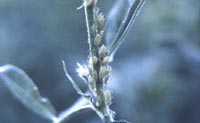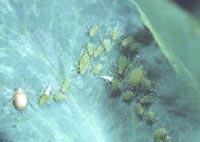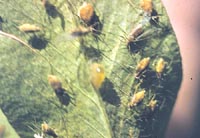Pea Aphids
Macrosiphum pisi

Figure 1. Pea Apids on Alfalfa
Description
The pea aphid is a pea-green, soft-bodied
insect about one-sixth inch long. The adult may be winged or wingless,
while the smaller nymphs, which resemble the adults, are wingless. The
nymphs shed their shins several times in the normal growth process;
these cast-off skins are white and quite noticeable on plants and on the
ground. Aphids produce a sugary, sticky material called "honey dew,"
which is visible on plants in moderate to severe infestations. Alfalfa,
clover, and garden peas are the plants on which the aphids usually feed.

Figure 2. Pea Aphid Adults,
Nymphs, and Mummy
(parasitized) on Pea Plant
Life Cycle
Pea aphids spend the winter in both the adult
and egg stages. Although in mild winters the adults may survive in the
crown of the plant or in debris on the ground, during a severe winter
most of the adults die and only the eggs survive. The overwintering eggs
are located in the stems of alfalfa and clover. During the summer all
individuals are females, the males appearing only in the fall. Each
female gives birth to 50 to 100 living young at the rate of 6 or 7 a
day. There are 7 to 20 or more generations a year. Most of the aphids
are wingless, but some winged forms are usually present. A large number
of winged forms may suddenly appear as a result of overcrowding or
climatic conditions. In this form they fly to nearby fields.
Damage
Alfalfa and red clover that is severely infested
may be stunted and occasionally may die. The tops of the plants are
generally damaged first. If the damage continues, the leaves may drop
from severely infested plants. Thus both quality and quantity of the hay
crop are affected. Pea aphids can almost always be found in alfalfa and
clover fields each year in the spring. Occasionally, however, severe
infestations do develop. If the infestation occurs early and plant
growth is slow, the plants will be severely stunted and may die. This
aphid is also suspected of transmitting certain virus diseases of
alfalfa.

Figure 3. Diseased Pea
Aphid on Alfalfa
Control
A fungus that infects the aphids kills them and
thus prevents widespread outbreaks. When the humidity is high and
temperatures are moderate, diseased aphids shrivel and turn.brovn. This
disease may develop into epidemic proportions and almost eliminate the
pest in a short time; if temperatures are low, however, the disease does
not develop. Several kinds of lady beetles and certain other insects
prey on these aphids and consume them in quantity. There is at least one
wasp that parasitizes aphids. At first the aphid body appears swollen;
then the wasp grub tnside cuts a hole in the back of the aphid to
escape. When the weather does not favor these natural enemies, chemical
control may become necessary. But no control measures should be used if
lady beetles are abundant.